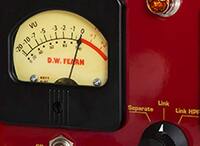
Review by George Shilling
I suspect that many readers outside the US have never heard of Geoffrey Daking. I hadn't. The man himself is a studio owner and 'audio tinkerer'. His units have been available in the US for a couple of years, and very quickly attracted a hugely impressive list of famous users. Now they are available in the UK.
If you read Daking's promotional literature, the names Trident, API and Neve make several appearances, and this upper echelon of the market is where he aims to compete. He criticises the cost-cutting aspect of modern console design philosophy, and takes a no-compromise approach. Discrete Class A circuitry is the order of the day here, (although the physical heat associated with such designs is, thankfully, not particularly apparent). Daking's US website claims that these models undercut API 500 series prices considerably, although after crossing the Atlantic there is not a huge difference when power supplies are taken into account.
These well-built units are somewhat larger than API modules. Each takes up a 1U rack-space. However, a glance around the back reveals fairly shallow, narrower cases, approximately the size of Neve 1073 modules, with metal braces attaching them to the full width of a standard rack front. Power comes from a separate box via 25-pin D-connector leads. The power supply can accommodate up to four modules. Daking also supplies a custom 4U rack case, which is padded and includes a top compartment for storing power supply and leads, with a neat Daking logo on the top - very natty.
All controls except the EQ Gain/Cut and Mic Pre Fader knobs are switchable. Much is made of the fact that the big metal knobs are custom made. I like their size, but they have a rough, clunky feel. Legending is unexceptional, but a vertical front panel arrangement is an option.
The Mic Pre's coarse switchable gain is slightly confusingly labelled with nominal input level rather than gain, so it looks backwards at first. Positions to the right are for Line input. In the centre of this is a fader pot, which negates any need to use a desk channel. Switches for Phase, Pad, Mute and Bypass all illuminate and utilise relays with gold contacts. The Mic Pre is wonderfully upfront and exciting, making instruments and vocals sound beautifully enhanced, even with lowly dynamic microphones. Everything sounds punchy and crystal clear, with astonishing presence, but paradoxically more natural than the perceived ultra-high frequency detail of Focusrite designs. This suits most acoustic instruments and vocals well, although very occasionally (such as with a mic'd bass cab) something less bold seemed more appropriate.
I loved the Mic Pre and would have thought a separate mic amp might be a popular unit at a lower price. It goes without saying that the noise and distortion figures are up with the best. Signal connections are XLR, mic input phantom is always on. The website PDF manual (no printed one was supplied) mentions an insert socket to enable pre-EQ compression, but this was not present on the review model. The EQ is four band, (two shelving and two peaking) with no bandwidth controls and just four switched frequencies per band (and an Off position). Daking makes the point that sweepable pots are cheap components, whereas switched knobs cost considerably more. These frequencies are based on a rare 1970's Trident design, and are extremely well chosen, with 17dB boost on the mid peaks, 15dB boost on the shelves, and 15dB cut across the board. This is very powerful, and really enjoyable to use when making gentle or bold changes to voices and instruments, as if one is sculpting the sound. Perhaps deliberately, there is no legending or calibration of the EQ Gain/Cut pots. There are also switched High- and Low-Pass 12dB per octave filters, each having only three settings.
The Compressor/Limiter features Line Input and Stereo Link sockets of the dual Jack/XLR type, while output is on XLR. The VU meter looks fairly cheap but seems to work well, although illumination may have been useful. It can be toggle-switched to show Input, Output and Gain Reduction. A second toggle-switch enables stereo-link and bypass modes. All rotary controls are switched, which with 2dB steps means any really fine threshold adjustment must be made externally with the level before signal arrives. Ratios can be chosen at 1.5:1, 2:1, 3:1, 5:1, 10:1 and 20:1. Of course, much depends on the Attack and Release settings. Attack is calibrated from 250µs to 64ms with nine settings. Release is labelled A to G (seven settings) and is quite novel. 'A', 'B' and 'C' represent fixed settings of 0.5, 1.0 and 1.5s respectively. Position 'D' replicates the dual time constant auto setting of the Neve 33609. 'E' is the dual time constant of the Audio Design Compex auto setting. 'F' and 'G' are copies of the triple time constant settings of the Fairchild 670 auto positions 5 and 6 respectively. These are superb recreations, and sound warm and smooth. The faster settings are great on drums and sometimes vocals.
Overall these are terrific units and surely qualify for a 'best kept secret' award. Highly recommended.
Reproduced with kind permission from www.georgeshilling.com. Copyright ©





